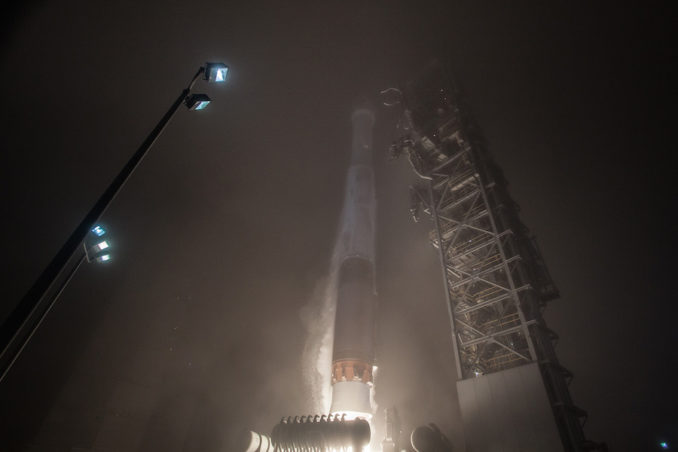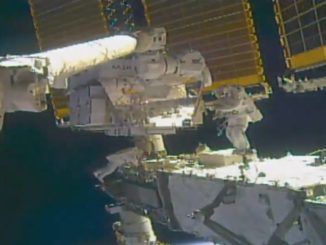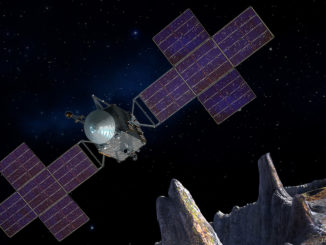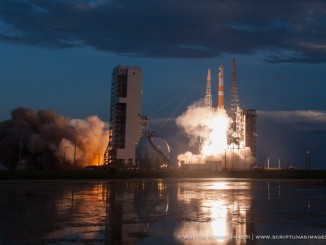
Making a fiery climb into a foggy sky Saturday over California’s Central Coast, a United Launch Alliance Atlas 5 rocket dispatched NASA’s InSight lander on a 301-million-mile voyage to Mars with a package of European-built instruments to probe the inside of the Red Planet.
The billion-dollar robotic mission took off at 4:05 a.m. PDT (7:05 a.m. EDT; 1105 GMT) Saturday from Space Launch Complex 3-East at Vandenberg Air Force Base, a secure military post northwest of Los Angeles that had never before hosted a launch to another planet.
A veil of fog flowed across Vandenberg and surrounding communities during the countdown, blocking views of the launch from observers who gathered to see the Atlas 5 rocket send the InSight mission to Mars. A rumble from the Atlas 5’s main engine — producing 860,000 pounds of thrust — permeated the marine layer, but most nearby rocket-watchers did not glimpse the launcher’s climb into space.
Powerful tracking cameras also had trouble following the Atlas 5, which disappeared into the fog a few seconds after liftoff. A long-rang infrared tracker stayed with the launcher, following the Atlas 5’s four-minute first stage engine burn.
The launcher’s Centaur upper stage took over the mission for two engine firings. The initial burn placed InSight into orbit around Earth, taking the interplanetary probe across the southern tip of South America, then north over the Indian Ocean east of Africa.
A second firing of the Centaur stage’s hydrogen-fueled RL10 engine gave InSight the speed it needed to break away from the gravitational pull of Earth. After achieving escape velocity, the Centaur released the 1,530-pound (694-kilogram) InSight spacecraft at 5:38 a.m. PDT (8:38 a.m. EDT; 1238 GMT).
A few moments later, two briefcase-sized CubeSats designed and built at NASA’s Jet Propulsion Laboratory deployed from a carrier on the Centaur’s aft bulkhead. The twin Mars Cube One, or MarCO, nanospacecraft will demonstrate miniaturized satellite technology in deep space, and they became the first CubeSats to leave Earth orbit with Saturday’s launch.
Ground controllers received the first signals from InSight through the Deep Space Network station at Goldstone, California, at 5:41 a.m. PDT (8:41 a.m. EDT; 1241 GMT), confirming the spacecraft was healthy following Saturday’s climb into space.
The MarCO CubeSats were expected to radio their status to engineers on Earth later Saturday.
NASA Administrator Jim Bridenstine, who took office April 23, called to congratulate the NASA and ULA launch team from the agency’s headquarters in Washington.
“This is a big day,” Bridenstine said. “We’re going back to Mars. We did it from the West Coast, which is a first-ever.
“This is an extraordinary mission with a whole host of firsts,” he said. “It’s important for our country. It’s also important for the world, and it really establishes American leadership in a lot of ways.”

InSight will conclude its 205-day interplanetary journey Monday, Nov. 26, with a dive into the Martian atmosphere. A thermal shield will protect the craft during descent, and a supersonic parachute and braking thrusters will slow InSight for a gentle touchdown at Elysium Planitia, an expansive equatorial plain that has not been visited by a previous spacecraft.
The MarCO CubeSats could provide a radio relay capability to beam telemetry from InSight directly to Earth as the lander drops into the Martian atmosphere. But InSight does not need the MarCO CubeSats to make a safe landing. The entry, descent and landing maneuvers will be pre-programmed into InSight’s on-board computer for the make-or-break arrival at Mars in November.
Once on the Martian surface, InSight will unfurl solar arrays and place two instruments on the ground using a robotic arm to listen for tremors and measure the heat flow coming from the planet’s super-heated interior.
“In this mission, we’ll probe the interior of another terrestrial planet, giving us an idea of the size of the core, the mantle, and the crust, and our ability to then compare that to the Earth,” said Jim Green, NASA’s newly-appointed chief scientist, and former head of the space agency’s planetary science division. “This is of fundamental importance for us to understand the origin of the solar system, and how it became the way it did today.”
“The goal of InSight is nothing less than to better understand the birth of the Earth, the birth of the planet we live on, and we’re going to do that by going to Mars,” said Bruce Banerdt, InSight’s principal investigator from the Jet Propulsion Laboratory.
Before InSight, all of NASA’s 20 previous Mars missions departed from Cape Canaveral, taking advantage of Earth’s rotation by launching toward the east. The extra momentum gives rockets an additional boost.
Vandenberg Air Force Base is typically host to launches into polar orbit, a type of orbit usually tailored for climate research missions, spy satellites and some communication applications.
But InSight is small, with a mass well below the lift capability of the United Launch Alliance Atlas 5 rocket, which flew in its basic “401” configuration with a four-meter payload fairing and no solid rocket boosters.
That means the Atlas 5 did not need the extra energy imparted during an eastward launch from Cape Canaveral, and ULA and NASA agreed to launch InSight from Vandenberg. The launch contractor proposed to base the mission from the West Coast because fewer Atlas 5 missions are scheduled from Vandenberg, so officials wanted to reduce the workload at ULA’s busier launch base in Florida.

Designers based the InSight lander on NASA’s Phoenix probe, which launched in August 2007 and touched down on the northern polar plains of Mars in May 2008. Diminishing solar power and cold temperatures limited Phoenix’s lifetime to about five months — two months longer than its three-month prime mission.
InSight will head for a broad plain near the Martian equator with ample sunlight year-round, providing enough warmth and solar power to keep the mission operating for nearly two years, or a little more than one Martian year, and potentially much longer.
Several course-correction maneuvers are planned during the trip, setting up for InSight’s one-shot descent through the Martian atmosphere.
Employing a similar entry, descent and landing profile as the Phoenix mission a decade ago, InSight will approach the target landing zone in Elysium Planitia, with its heat shield absorbing blistering temperatures up to 2,700 degrees Fahrenheit, before unfurling a parachute and firing downward-facing rocket thrusters to settle to a gentle touchdown.
Mission managers selected the nearly featureless landing target because of its safety. There are few surface hazards that could spell doom for InSight, and Banerdt, the mission’s chief scientist, calls it the “biggest parking lot on Mars.”
InSight was originally supposed to launch in March 2016, but problems sealing a vacuum enclosure containing one of the lander’s primary instruments, a French-developed seismometer, forced officials to postpone the mission. Mars launch opportunities come once every 26 months, when the planets are in the proper positions in the solar system, so the next chance to send InSight to the Red Planet came Saturday.
Engineers redesigned the vacuum enclosure to eliminate an air leak in a feed-through, or wiring interface, used route data between the seismic sensors inside the instrument and electronics and communications equipment aboard the InSight spacecraft.

The protective enclosure keeps out wind and other environmental conditions that could disrupt the sensitive seismic measurements. It must keep a seal through the large day-and-night temperature swings on Mars.
“One of these feed-throughs was not capable of maintaining itself through the large temperature extremes,” Banerdt said. “When we actually tested at Mars conditions going down to minus 100 or minus 120 degrees Celsius (minus 148 to minus 184 degrees Fahrenheit), it developed a very tiny crack and started leaking — started allowing some air to come in.
“This was enough to upset the whole apple cart in terms of the sensitivity of the seismometer,” Banerdt said.
JPL took over responsibility for fabricating a new enclosure, while the French space agency, CNES, remained in charge of the instrument’s internal sensors.
The two-year delayed added roughly $150 million to InSight’s cost, which now sits at more than $993 million, including launch and operations expenses. That figure includes an investment valued at approximately $180 million from the French and German space agencies.
The twin MarCO spacecraft cost another $18.5 million, according to NASA.
One of InSight’s first jobs will be to take panoramic pictures to survey the landing site, a region unexplored by past Mars missions. InSight carries cameras based on technology originally developed for the Opportunity and Curiosity rovers, but with added capability for color imagery.
A nearly 8-foot-long (2.4-meter) robotic arm will place the seismometer and heat probe on the Martian surface next to the lander after touchdown. InSight’s robotic arm was originally built for the canceled Mars Surveyor lander that was supposed to launch in 2001.
Other leftover parts on InSight include a landing radar originally built as a spare for the Phoenix mission, and surplus structural booms from the Curiosity rover repurposed for a Spanish-built weather station on InSight to collect temperature and wind data.
Once placed on the surface of Mars, the German-made Heat Flow and Physical Properties Package, know as HP3, will hammer to a depth of 16 feet, or 5 meters, a process expected to take around six weeks with roughly 10,000 individual hammer blows, accounting for several planned pauses to allow the instrument to record thermal conductivity measurements.
“If you have an astronaut on the planet, you can do this in maybe 20 minutes or half an hour,” Banerdt said of the heat flow experiment. “But if you want to do it robotically, you have to get a little bit more clever.”
The metallic mole will probe deeper into the Martian crust than any past lander.
“We think this remote probe can actually go down about 15 feet, which gives us a better baseline to measure the temperature increase with depth and be able to estimate the amount of heat coming out of Mars,” Banerdt said.
“And that amount of heat is tied to the geological activity of the planet. It’s the heat engine of the planet that drives volcanism, it drives tectonic activity, it drives mountain-building. So all the geological processes that happen on a planet are driven by its heat engine, and we want to measure sort of the vigor of that heat engine.”
“We switch on the temp sensors and record the temperature over depth and time for up to two years,” said Tilman Spohn, HP3 investigation lead from DLR, the German Aerospace Center, in Berlin. “Taking the temperature gradient, or the rate at which the temperature increases (with depth), gives us the heat flow. Very simple and straightforward, but as planetary science often is, very difficult. The devil is in the details.”
The seismometer will get to work listening for marsquakes.
“Sensitive is really an understatement,” Banerdt said of the seismometer. “Tt’s an exquisitely sensitive device for measuring the motion of the ground. And when we talk about motion, we’re talking about vibrations that have an amplitude comparable to the size of an atom.
“These are waves that were generated, maybe, by a marsquake on the other side of the planet, have traveled all the way through the planet, getting their waveform modified as they go through the planet and picking up information about the deep interior structure, and then we are able to pick it up when it comes back up to the surface under the seismometer,” Banerdt said.
Spaceflight Now members can read a transcript of our full interview with Bruce Banerdt. Become a member today and support our coverage.
The seismic sensors aboard InSight evolved from mission concepts in the 1990s and 2000s that would have dispatched multiple small probes to Mars, creating a global geophysical network. InSight will give scientists just one seismic station, but experts have developed techniques to glean information about the interior of Mars, even with a single seismometer.
Researchers have attempted seismic detections on Mars before, but seismometers on NASA’s Viking landers in the 1970s provided inconclusive results. The instruments were mounted the decks of the landers, making them susceptible from interference from spacecraft vibrations and winds.
“Not only do you have to have a very sensitive device for measuring those motions but you have to protect it from everything else that might affect it,” he said. “We have several different layers of protection, it’s sort of like a Russian doll.”
An electrical and data cable will connect the seismometer to the InSight lander.
Philippe Lognonné, head of the InSight seismic investigation team at the Institut de Physique du Globe de Paris in France, said scientists do not have a confirmed detection of marsquake, but evidence suggests weak tremors occur on the red planet.
“We have no clear data on seismic activity on the planet,” Lognonné in an interview with Spaceflight Now. “We imagine it because we see faults on the surface. In some places, we have seen where a boulder may have fallen down from a scarp. But again, we have no data.”
Lognonné said, based on existing theoretical models, the seismometer could register around 20 or 30 quakes per year, sensing ripples from all types of seismic waves moving through the planet.
“We cover all the seismic waves, and we even have sensitivity to tides, the Phobos tide especially,” Lognonné said. “We cover all the signals to be generated by a quake.”
Scientists will also measure Mars’ polar wobble by analyzing radio signals transmitted between InSight and Earth-based antennas.
“By the timing of that signal, we can track the location of the spacecraft at Mars … with an accuracy of something around a foot or so, maybe a little bit less,” Banerdt said. “To me, that’s the closest we can get to magic with science.”
With that information, scientists can determine which way the Martian north pole is pointing as the planet rotates.
“Over the course of a year, we can watch the north pole wobble just a little bit because of the core sloshing around inside of the planet, and that will give us a very, very tight constraint on the size of that core and its density, and so its composition,” Banerdt said. “That tells us the structure of Mars. The structure of Mars tells us something about the processes that put that structure together. We can put this into our mdoels, extrapolate it to Earth, and understand how the Earth formed four-and-half billion years ago.”
Much of the ancient geologic record on Earth has eroded away, but Mars may still hold clues about how it was born, accreted rock and dust, and formed a hot, high-pressure mantle and core as heavier elements sunk deep beneath its surface.
“How we get from a ball of featureless rock into a planet that may or may not support life is a key question in planetary science,” Banerdt said. “And these processes that do this all happen in the first tens of millions of years.”
Discoveries made by InSight at Mars could inform scientists how the Earth formed and evolved.
“Mars is a smaller planet,” Banerdt said. “It’s less active than the Earth, so it has retained the fingerprints of those early processes in its basic structure — the thickness of the crust, the compositon of the mantle, the size and composition of its core,” he said. “By mapping out these boundaries, these various different sections of the inside of the planet, we can then understand better how the planet formed, and how our planet got to be the way it is.”
Email the author.
Follow Stephen Clark on Twitter: @StephenClark1.



